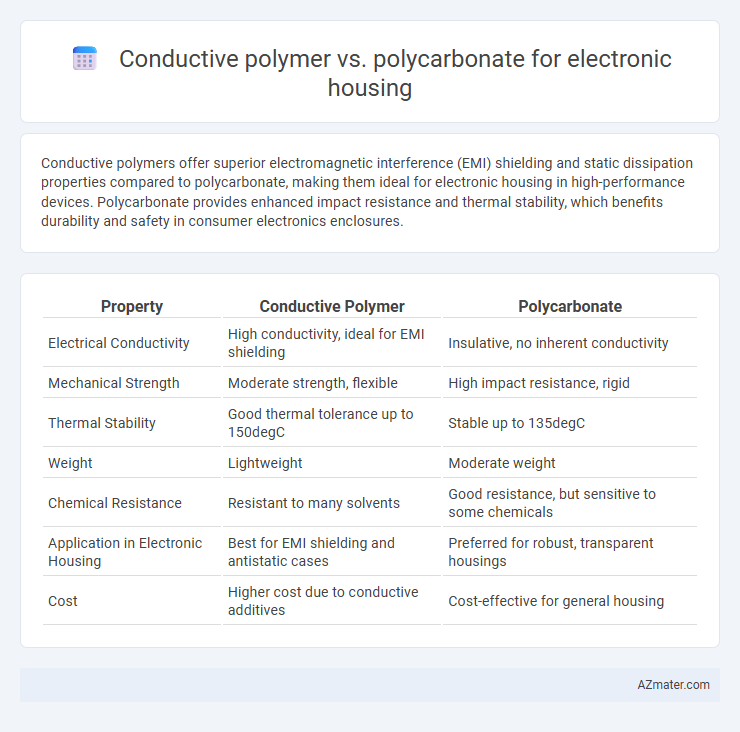Conductive polymers offer superior electromagnetic interference (EMI) shielding and static dissipation properties compared to polycarbonate, making them ideal for electronic housing in high-performance devices. Polycarbonate provides enhanced impact resistance and thermal stability, which benefits durability and safety in consumer electronics enclosures.
Table of Comparison
| Property | Conductive Polymer | Polycarbonate |
|---|---|---|
| Electrical Conductivity | High conductivity, ideal for EMI shielding | Insulative, no inherent conductivity |
| Mechanical Strength | Moderate strength, flexible | High impact resistance, rigid |
| Thermal Stability | Good thermal tolerance up to 150degC | Stable up to 135degC |
| Weight | Lightweight | Moderate weight |
| Chemical Resistance | Resistant to many solvents | Good resistance, but sensitive to some chemicals |
| Application in Electronic Housing | Best for EMI shielding and antistatic cases | Preferred for robust, transparent housings |
| Cost | Higher cost due to conductive additives | Cost-effective for general housing |
Introduction to Electronic Housing Materials
Conductive polymer and polycarbonate are prominent materials used for electronic housing due to their distinct properties. Conductive polymers offer electrical conductivity and electrostatic discharge (ESD) protection, making them ideal for sensitive electronic components. Polycarbonate, known for its high impact resistance, thermal stability, and transparency, provides robust mechanical protection and is widely used in durable consumer electronics enclosures.
Overview of Conductive Polymers
Conductive polymers are organic polymers that conduct electricity, offering an excellent balance of electrical conductivity and mechanical flexibility for electronic housing applications. These materials possess intrinsic conductivity due to conjugated molecular structures, enabling efficient electromagnetic interference (EMI) shielding and static dissipation. Compared to polycarbonate, conductive polymers provide superior anti-static properties and electromagnetic compatibility, making them ideal for protecting sensitive electronic components.
Understanding Polycarbonate in Electronics
Polycarbonate offers high impact resistance, excellent dimensional stability, and superior electrical insulation, making it a popular choice for electronic housings. Its inherent flame retardancy and thermal resistance support device safety and durability in demanding environments. While conductive polymers provide electrical conductivity, polycarbonate excels in protecting sensitive electronics from mechanical stress and environmental factors.
Key Physical Properties Comparison
Conductive polymers offer excellent electrical conductivity combined with lightweight and flexibility, making them ideal for EMI shielding and static dissipation in electronic housings. Polycarbonate excels in impact resistance, thermal stability up to 150degC, and transparency, providing durable protection and design versatility for enclosures. While conductive polymers improve electromagnetic compatibility, polycarbonate remains superior in mechanical strength and dimensional stability under stress.
Electrical Performance in Electronic Enclosures
Conductive polymers offer superior electromagnetic interference (EMI) shielding and static dissipation compared to polycarbonate, making them ideal for protecting sensitive electronic components from electrical disturbances. Polycarbonate, while providing excellent mechanical strength and impact resistance, lacks inherent electrical conductivity and often requires additional coatings or additives to achieve comparable electrical performance in enclosures. Selecting conductive polymers for electronic housing enhances signal integrity and reduces the risk of electrostatic discharge (ESD), crucial for high-performance electronic devices.
Thermal Stability and Heat Resistance
Conductive polymers exhibit superior thermal stability with decomposition temperatures typically above 300degC, making them suitable for electronic housing exposed to high temperatures. Polycarbonate offers moderate heat resistance, with a heat deflection temperature around 130degC, limiting its use in high-heat electronic applications. The higher thermal stability of conductive polymers ensures durability and reliability in electronics requiring effective heat dissipation and prolonged thermal exposure.
Mechanical Strength and Durability
Conductive polymers offer moderate mechanical strength with enhanced electrical conductivity, making them suitable for electronic housings requiring static dissipation and EMI shielding. Polycarbonate exhibits superior mechanical strength, impact resistance, and durability, providing robust protection against physical damage and environmental stress. While polycarbonate dominates in toughness and longevity, conductive polymers balance electrical functionality with acceptable mechanical performance for specialized electronic enclosure applications.
Cost-Effectiveness and Manufacturing Considerations
Conductive polymers offer enhanced electromagnetic interference (EMI) shielding and static dissipation at a higher material cost compared to polycarbonate, which provides excellent impact resistance and clarity with more cost-effective mass production. Polycarbonate's ease of injection molding and wide availability contribute to lower manufacturing expenses, while conductive polymers often require specialized processing techniques, increasing complexity and production time. Choosing between these materials depends on balancing the specific electronic housing requirements for conductivity and shielding against budget constraints and manufacturing scalability.
Applications and Industry Use Cases
Conductive polymers are extensively used in electronic housings for applications requiring static dissipation and electromagnetic interference (EMI) shielding, making them ideal for consumer electronics, medical devices, and aerospace components. Polycarbonate is preferred in industries demanding high impact resistance, optical clarity, and flame retardance, such as automotive electronics, telecommunications, and industrial control panels. Both materials find critical roles in protective casings, but conductive polymers specifically address electrical conductivity needs, while polycarbonate excels in mechanical durability and thermal stability.
Choosing the Right Material: Conductive Polymer vs Polycarbonate
Conductive polymers provide excellent electromagnetic interference (EMI) shielding and static dissipation, making them ideal for electronic housings in sensitive applications requiring electrostatic discharge protection. Polycarbonate offers superior impact resistance, heat resistance up to 135degC, and transparency, favoring durable housings where mechanical strength and optical clarity are essential. Selecting between conductive polymer and polycarbonate depends on prioritizing electrostatic protection versus mechanical toughness and thermal stability for the specific electronic device requirements.

Infographic: Conductive polymer vs Polycarbonate for Electronic housing
 azmater.com
azmater.com